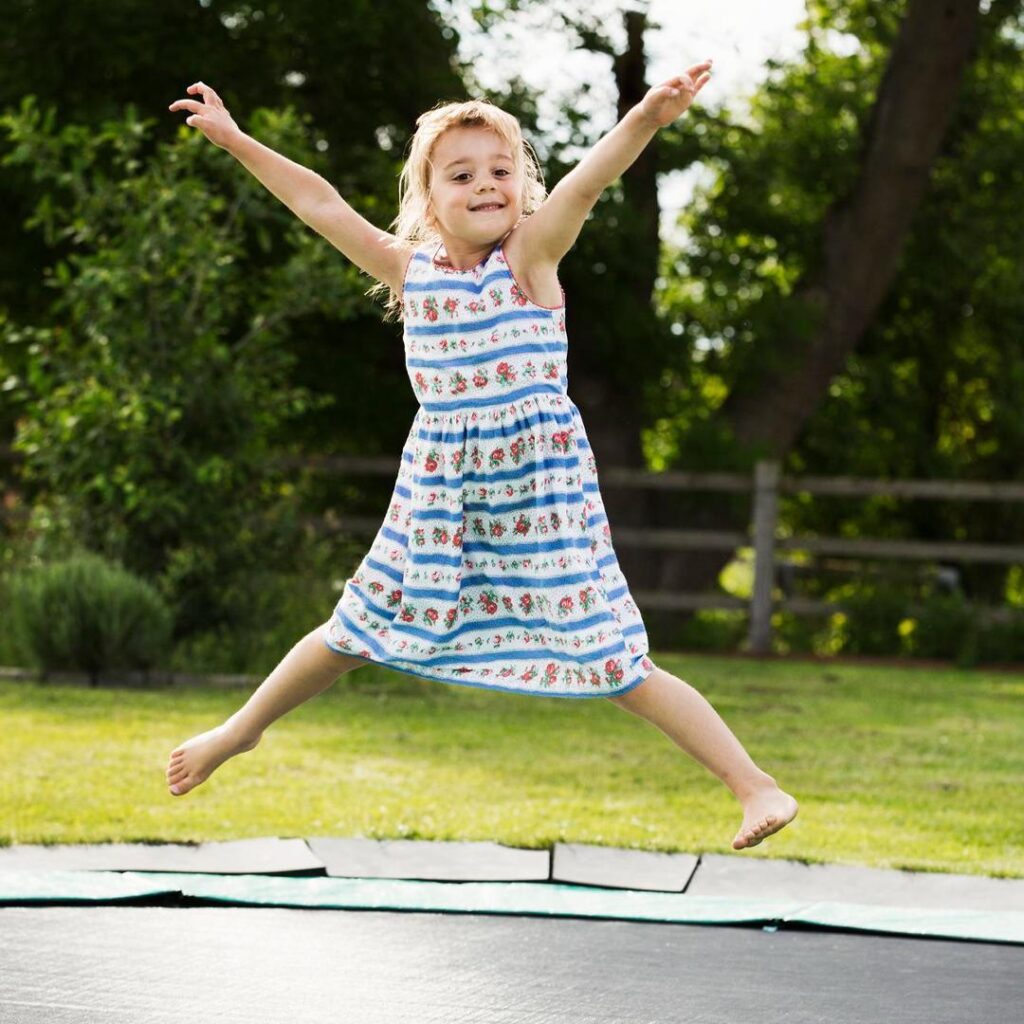From garden fun and fitness equipment to science experiment tools, trampolines have come a long way. Who knew such an enjoyable piece of equipment could make mundane science experiments thrilling? Trampoline is a magic carpet, transforming playtime into a thrilling journey of discovery and learning.
Engaging children in physical activity while they learn, not only helps them understand science better but also keeps them active and healthy. Trampolines provide the perfect blend of fun and education, making science experiments a lively and memorable experience.
We will explore science experiments using trampolines, measuring jump heights, and understanding energy transfer. Trampolines illustrate biological principles by showing changes in heart rate and muscle usage. NASA uses trampolines in astronaut training, highlighting their significance in scientific applications.

The Science Behind Trampolines
Inground Trampolines operate on fundamental physics principles such as gravity, force, and energy. Gravity pulls objects towards the Earth, and on a trampoline, it’s what brings you back down after each bounce. When you jump, you exert force on the trampoline mat, which pushes back, propelling you upwards. This interaction demonstrates Newton’s Third Law of Motion: for every action, there is an equal and opposite reaction.
Moving on from the science behind trampolines, let’s explore how these bouncy platforms can also illustrate principles of physics.
Fun Physics Experiments
Exploring physics with a family trampoline can be both educational and fun. Here are two simple experiments that demonstrate key principles of physics, using easy-to-find materials.
Experiment 1: Measuring Jump Height
Tools Needed
- Tape measure
- Chalk
Procedure
- Preparation: Have the child stand on the trampoline.
- Jumping: Ask the child to jump as high as they can. While they are airborne, mark the highest point they reach on a nearby wall or a stick placed vertically using chalk.
- Repetition: Repeat this process several times to ensure accuracy.
- Measurement: Use the tape measure to record the height of each jump from the trampoline mat to the chalk mark.
- Data Analysis: Compare the recorded heights to see how consistent they are. Discuss factors that might affect the results, such as the child’s jumping technique, the amount of force applied, and fatigue levels over multiple jumps.
Discussion Points
- Explain how gravity pulls the child back down to the trampoline.
- Discuss how the force exerted on the trampoline mat influences the height of the jump.
- Highlight how repeating the experiment helps to gather reliable data.
Experiment 2: Bouncing Ball Energy Transfer
Tools Needed
- Various balls (basketball, tennis ball, rubber ball, etc.)
Procedure
- Preparation: Gather different types of balls.
- Dropping Balls: Have the child drop each ball from the same height onto the trampoline.
- Observation: Observe and measure how high each ball bounces after hitting the trampoline.
- Recording: Record the bounce heights for each type of ball.
- Comparison: Compare the recorded heights to determine which ball bounces the highest and which the lowest.
Discussion Points
- Explain the concept of energy transfer from the ball to the trampoline and back.
- Discuss why different materials and weights affect the bounce height.
- Highlight how the elasticity of the ball and the trampoline mat contribute to the energy transfer.
By conducting these experiments, children can see physics in action and better understand the principles of gravity, force, and energy.
Now that we’ve explored the physics behind trampolines, let’s dive into how trampolines can help illustrate principles of biology, including changes in heart rate and muscle usage.
But wait do you know: Trampolines are not only making waves in science experiments and NASA training but also helping children manage conditions like ADHD. They provide a fun and effective way to improve focus and energy levels.
Biology and Trampolines
Exploring biology with sport trampolines offers a fascinating way for children to learn about their bodies. By observing changes in heart rate, muscle use, and balance, children can gain insights into human physiology and the benefits of physical activity.
Experiment 3: Human Physiology
Observing Heart Rate Changes
- Preparation: Have the child sit quietly for a few minutes to establish a resting heart rate.
- Measurement: Use a stopwatch and count the child’s heartbeats for 30 seconds, then double the number to get the beats per minute (bpm).
- Jumping: Let the child jump on the trampoline for five minutes.
- Post-activity Measurement: Immediately after jumping, measure the heart rate again using the same method.
- Comparison: Compare the resting heart rate to the post-jumping heart rate.
Discussion Points
- Explain how physical activity increases heart rate to pump more blood and oxygen to the muscles.
- Discuss the benefits of cardiovascular exercise for overall health.
- Highlight how regular physical activity can improve heart health and endurance.
Understanding Muscle Use and Energy Expenditure
- Preparation: Discuss with the child which muscles they think they use while jumping (e.g., legs, core, arms).
- Observation: Have the child jump on the trampoline and pay attention to the muscles they feel working.
- Analysis: After jumping, ask the child which muscles feel tired or sore.
- Discussion: Explain how jumping on a trampoline engages multiple muscle groups and increases energy expenditure.
Discussion Points
- Describe how muscles work in coordination to perform physical activities.
- Discuss the importance of strength and conditioning for overall physical health.
- Highlight how trampoline exercises can build strength and endurance.
Experiment 4: Balance and Coordination
Simple Balance Tests
- Preparation: Have the child stand on one foot on solid ground and time how long they can maintain their balance.
- Jumping: Let the child jump on the trampoline for five minutes.
- Post-activity Test: Repeat the balance test on solid ground.
- Comparison: Compare the balance times before and after jumping.
Discussion Points
- Explain how jumping on a trampoline challenges and improves the body’s balance mechanisms.
- Discuss how the body adapts to maintain balance and coordination through repeated practice.
How Fitness Trampolines Help Improve Coordination
- Observation: Have the child perform simple coordination tasks, like touching their nose with alternating hands, before and after jumping.
- Analysis: Observe any improvements in speed and accuracy after jumping.
- Discussion: Explain how the dynamic movements on a trampoline enhance the brain’s ability to coordinate muscle movements.
Discussion Points
- Describe how regular trampoline use can enhance motor skills and coordination.
- Discuss the benefits of improved coordination for other physical activities and daily tasks.
Engaging in these biology experiments helps children understand the effects of physical activity on their bodies. They learn how their heart rate changes, which muscles they use, and how their balance and coordination improve with regular exercise.
Tip: If you’re inspired by the idea of trampolines, check out the amazing sale at Akrobat Trampoline. Visit Akrobat Trampoline today to grab your own and bring the fun of bouncing science experiments to life!
Now that we’ve examined how trampolines can help illustrate principles of biology, let’s explore how NASA uses trampolines in astronaut training, highlighting their significance in advanced scientific applications.
NASA’s Use of Trampolines
NASA’s training programs are essential for preparing astronauts for the challenging conditions of space. Among the various tools and techniques they use, trampolines play a significant role in simulating microgravity and enhancing physical conditioning.
Overview of NASA’s Training Programs: NASA’s training programs encompass a wide range of activities designed to prepare astronauts for the unique environment of space. These programs include physical conditioning, simulations of spacewalks, and exercises to improve coordination and balance. By using specialised equipment, NASA ensures that astronauts are ready for the rigours of space travel.
How Astronauts Use Trampolines to Simulate Microgravity
- Simulation of Microgravity: In the absence of actual weightlessness, trampolines help astronauts experience a semblance of microgravity. When they jump on a trampoline, the brief moments of free-fall mimic the sensation of floating in space.
- Balance and Coordination: Trampolines challenge the body’s balance mechanisms, which is crucial for astronauts who must navigate the zero-gravity environment of space. By practising on trampolines, astronauts improve their ability to maintain stability and control their movements.
- Physical Conditioning: Jumping on trampolines is an effective cardiovascular workout that helps astronauts build the stamina and strength needed for space missions. This exercise engages multiple muscle groups, ensuring that astronauts stay fit and healthy.
By incorporating trampolines into their training routines, NASA ensures that astronauts are well-prepared for the challenges of space travel. These exercises not only simulate the conditions of microgravity but also enhance the physical and mental agility needed for successful missions.
Having explored how NASA utilises trampolines for astronaut training, let’s now look at how you can integrate trampoline science experiments at home, making learning both fun and educational for your children.
Integrating Trampoline Science Experiments at Home
Bringing trampoline science experiments into your home can make learning exciting and interactive for your children. By following these tips, you can create a safe and engaging environment that fosters curiosity and discovery.
Tips for Parents on Setting Up a Safe and Engaging Science Experiment Environment
- Safety First: Ensure the trampoline is in good condition, with no tears or loose springs. Use safety trampoline accessories and padding to prevent accidents. Make sure children wear appropriate clothing and avoid sharp objects.
- Clear Space: Set up the trampoline in a clear area free from obstacles. This space should be well-lit and spacious enough for children to move around safely.
- Materials Ready: Gather all necessary materials for the experiments in advance. This includes measuring tapes, chalk, various balls, stopwatches, and recording sheets.
- Supervision: Always supervise children during the experiments to ensure they are following safety guidelines and conducting the activities correctly.
Encouraging Children to Ask Questions and Make Observations
- Prompt Curiosity: Encourage your children to ask questions about what they observe. For example, “Why do you think this ball bounces higher than the others?” or “How do you feel after jumping for a while?”
- Guided Exploration: Guide them through the experiments by asking them to predict outcomes, observe the results, and explain what they see. This active participation helps reinforce their understanding.
- Interactive Learning: Turn the experiments into a fun challenge. For instance, who can jump the highest, or which ball will bounce the most? This keeps children engaged and motivated.
Recording Results and Discussing Findings
- Data Collection: Teach children how to record their observations accurately. Use simple charts or tables to note down measurements, times, and any changes observed during the experiments.
- Analyse Together: After completing the experiments, sit down with your children to discuss the results. Ask questions like, “What did you notice?” and “Were your predictions correct?”
- Understanding Results: Help them understand the science behind their observations. Explain why certain results occurred and how they relate to the scientific principles being studied.
- Encourage Reflection: Encourage children to think about how they could improve their experiments or what new questions they have based on their findings.
By integrating trampoline science experiments at home, you can create a dynamic learning environment that makes science both fun and educational. Your children will not only enjoy the physical activity but also develop a deeper understanding of scientific concepts through hands-on experience.
Only for you: If you also want to combine fun and learning through trampoline experiments, visit Super Tramp Trampoline today. You can provide a unique opportunity for children to explore science interactively and engagingly. Encourage curiosity, ensure safety, and discuss findings to make these experiments memorable and educational.
Conclusion
Using trampolines for science experiments offers numerous benefits. Children learn about gravity, force, and energy while staying active. Trampolines also boost heart health, muscle strength, balance, and coordination, making science both enjoyable and beneficial.
I encourage parents to explore other playful and educational activities that spark curiosity and engagement. When children find learning enjoyable, they become more enthusiastic about discovering new concepts.
Share your trampoline science experiment experiences in the comments below! Let’s keep learning fun and interactive for everyone.
Trampolines illustrate principles of physics like elastic potential energy and kinetic energy. When you jump, the trampoline’s springs store and then release energy, propelling you upward.
Trampolines aid in developing motor skills, balance, and coordination. The bouncing action helps improve spatial awareness and strengthens muscles, contributing to overall physical and cognitive growth.
Using a trampoline can enhance understanding of physics concepts like gravity and momentum. It also promotes physical fitness, improves coordination, and encourages healthy, active play.
Add accessories like a safety net, fun bouncing games, or even a sprinkler for a splashy experience. Incorporate challenges and tricks to keep it exciting and engaging.
Trampolines were invented in the 1930s by circus acrobats. They were initially used for training astronauts to simulate zero gravity and have been featured in various sports and performances.





